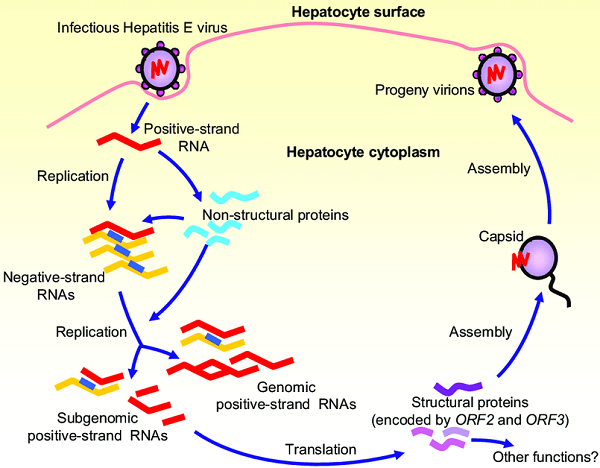Hepatitis E virus - Transmission, Pathogenesis, Host immunity, Syndromes, Lab diagnosis, Treatment
Transmission of Hepatitis E virus
Hepatitis E virus transmission mostly occurs via the fecal-oral route, rarely by blood products.
Pathogenesis of Hepatitis E virus
The incubation period of the Hepatitis E virus is of 2-9 weeks with an average of 35 days. The infection is usually, a self-limiting disease that is similar to HAV.
After a short prodromal phase with fatigue and nausea preceded the icteric phase that includes jaundice. In immunocompromised patients (organ transplant recipients), Hepatitis E virus may cause chronic infections.
The Hepatitis E virus infection may cause liver fibrosis and cirrhosis (fatality- 1.3%), encephalopathy, and disseminated intravascular coagulation. Serious infection in pregnant women, especially in the last trimester of pregnancy (fatality rate 15-20%) may cause fulminant hepatic failure (rate high).

Fig: HEV replication (Source: ResearchGate)
Host immunity of Hepatitis E virus
IgM Ab appears first which falls rapidly after infection and becomes undetectable within 6 months. Anti Hepatitis E virus IgG presents longer than 6 months and provides protection from reinfection.
Clinical syndromes of Hepatitis E virus
The clinical syndromes of Hepatitis E virus includes:
Liver fibrosis and cirrhosis
encephalopathy, disseminated intravascular coagulation
fulminant hepatic failure in pregnant women (rate high)
pathological findings include:
infiltration of the portal tract by lymphocytes and polymorphonuclear leukocytes
balloon hepatocytes
formation of acidophilic bodies
intralobular necrosis of hepatocytes
Lab diagnosis of Hepatitis E virus
The laboratory diagnosis of the Hepatitis E virus is done after the collection of the specimen/sample.
Specimen
Stool
Blood
(not yet cultured)
Serodiagnosis
Serodiagnosis, a commonly used test for Hepatitis E virus infection includes the detection of IgM and IgG anti-HEV antibodies and detection of Hepatitis E virus RNA
Western blot and EIA using antigenic domains from ORF2 and ORF3 are done for serodiagnosis
detection of anti-HEV IgM and IgG helps to differentiate acute and chronic infections
Molecular diagnosis
A molecular diagnosis such as PCR detects Hepatitis E virus RNA in blood, and serum.
Treatment of Hepatitis E virus
Treatment of Hepatitis E virus infection are done:
no vaccines are available; supportive therapy offered
1st step of treatment- reduction of immunosuppression medication
2nd step of treatment- administration of pegylated interferon α with ribavirin
treatment duration varies